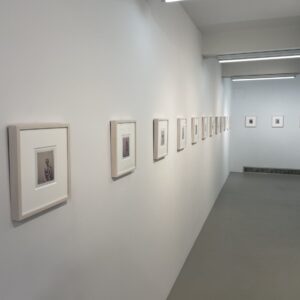JTF (just the facts): Co-published by Fw:Books (here) and Light Work (here). Softcover, staplebound reversed gatefold, 384 pages, with about 300 color and black and white photographs. In an edition of 800 copies. Includes interviews recorded by the artist. Design by Hans Gremmen. (Cover and spread shots below.)
Comments/Context: In 2012, after living and working abroad for seven years, Andres Gonzalez returned back to the United States. Just a few weeks later, a mass shooting happened at Sandy Hook Elementary School in Newtown, Connecticut, killing 26 people – 20 of them children. It stunned the country, and had a strong emotional impact on Gonzalez. He started to closely follow the aftermath. The shooting renewed the gun control debate, and multiple gun laws were proposed; however, in April 2013, the US Congress failed to pass key legislation requiring universal background checks. Angered by the government’s inaction, Gonzalez got involved more deeply, ultimately spending the past six years visiting and documenting communities affected by school shootings.
When Gonzalez began working on the project, he had no clear idea how to approach or photograph it. He started his research at Northern Illinois University, where five students were killed in 2008. A librarian showed him an archive of memorabilia accumulated as a response to the tragedy. Gonzalez learned that after a mass school shooting, letters and gifts are sent to these communities in huge numbers. “What I wasn’t really expecting was to see the massive amount of material that they had collected. It just went on and on and on.”
Gonzalez turned his project into a photobook, attempting to unpack the complexity of the mass shooting epidemic in American schools. The title of the book American Origami refers to a Japanese legend that promises anyone who makes a thousand origami paper cranes in one year will be granted any wish. This belief became known because of the story of Sadako Sasaki, a twelve year old Japanese girl who had been fighting cancer caused by radiation exposure from the US bombing of Hiroshima. She started folding paper cranes while at the hospital; she died in 1955, exceeding her goal. Sadako became a national heroine, and the origami crane became a symbol of healing and hope. In a fictionalized American version of the story, Sadako creates 644 cranes before her death and her classmates fold the remaining cranes, and so paper cranes also became a symbol of the American grief ritual.
As a photobook, American Origami boldly experiments with construction – it is a softcover book designed as staple-bound reversed gatefold. A photograph of a red patterned paper crane appears on the cover, and a white rectangle contains the title of the book, the photographer’s name, and the locations of the schools documented in the project, as if on a folder label. Inside, the book is divided into sections for each school shooting, with specifics (the name and location of the school, the date and time of the shooting, the number of deaths and non-fatal injuries) crisply listed. The design of the book, with its concise structure and its attention to detail, is reminiscent of a formal report.
The project documents seven mass shootings in American schools, moving from Columbine High School in Littleton, Colorado, to Marjory Stoneman Douglas High School in Parkland, Florida. Each section has a similar structure: quiet photographs of the towns, the rhythms of daily life, the surrounding landscapes, the forensic documents, and the schools themselves. Gonzalez’ photographs are rooted in the mundane and the universal, where loss is presented through the emptiness of the streets and places. His understated images are interwoven with poignant interviews, adding a layer of intimate personal memories and reflections to the visual flow.
As the pages fall back and out, they reveal a hidden archive of additional imagery – still life photographs of handwritten letters and notes, children’s drawings, newspaper clippings, handmade sculptures, goggles, a paper crown, a candle, flowers, toys, paper cranes, and countless other objects. While talking to people, Gonzalez came to realize that all this memorabilia became a weight for the community – the families don’t actually want it all, and ultimately, cities and schools take the responsibility to collect and archive the submissions. Over 65,000 teddy bears and half a million letters were sent to Sandy Hook. In an interview, Kristina Anderson, a Virginia Tech survivor, says that “sending a card or flowers or whatever, that really is more for the sender then it is for the receiver, especially if you don’t know the person.”
Across the various tragedies, these varied elements repeat again and again, reinforcing the patterns of violence, the accumulation of grief memorabilia, and the insufficiency of collective response. Even the language used in the writings repeats from one tragedy to another. The last page of the photobook gathers together screenshots of four American Presidents in similar moments of grief during their televised remarks, powerfully asking us how we move beyond the act of collective grieving to actions that make a difference.
As we move through the book, the landscapes, the memorabilia, and the personal stories deliberately blend one into another, immersing us in an endless cycle of repeated gun violence. While the construction of the book is intriguing, in practice, the act of engaging (constantly opening and closing) with the second layer of photographs can be frustrating, and more distracting than rewarding; the book cover seems too fragile for such active interaction. The subject of gun violence is a tough one to present through photography, and for that alone, American Origami stands as a remarkable attempt to unravel and comprehend the epidemic of mass shootings in American schools. It reminds us that while condolences have their place, to truly address the problem, there is much more that must be done.
Collector’s POV: Andres Gonzalez does not appear to have gallery representation at this time. As a result, collectors interested in following up should likely connect directly with the artist via his website (linked in the sidebar).































